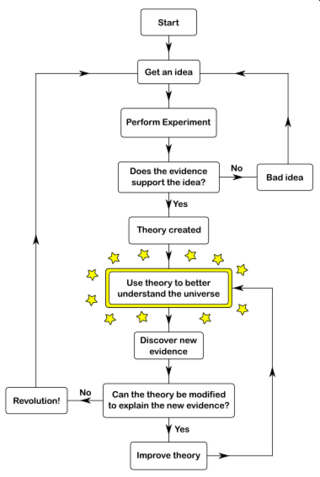Scientific theory
explanation of some aspect of the natural world which can be tested and corroborated From Wikipedia, the free encyclopedia
Remove ads
In everyday speech, the word "theory" is used as a "best guess". In modern science, a scientific theory is a hypothesis that has been tested and explains a lot things. If anyone finds proof that all or part of a scientific theory is false, then that theory is either changed or thrown out.

An example of a scientific theory that changed a lot is the germ theory of disease. In ancient times, people believed that diseases were caused by the gods, or by curses, or by people doing bad things. improper. Germs (microorganisms) were unknown, because germs are too small to see. With the microscope was invented, people found out about germs were and came up with the germ theory. Because of the germ theory of disease but the germ theory of disease had to be changed, because some diseases work differently than others. The flu and scurvy are examples of diseases that are not caused by bacteria, but viruses or bad eating. Scientists changed the germ theory of disease, so that today we would say that the theory is "Some diseases are caused by germs".
To be a scientific theory, a theory must be tested a large number of times, by different scientists in different places, and must pass the test every time. The theory must be stated exactly, sometimes using mathematics. And it must fit in with all of the other scientific theories. Science has many branches. Physics, chemistry, biology, geology, and astronomy are some of the major branches of science. A scientific theory in one branch of science must hold true in all of the other branches of science. For example, the atomic theory of matter, that all matter is made up atoms was discovered using physics, but the chemicals used in chemistry, the living Tissue used in biology, the rocks studied in geology, and the planets studied in astronomy are all made of atoms. The atomic theory of matter holds in every area of science.
Sometimes scientists come up with a theory that is wrong. The discovery of an exception to a scientific theory is a major event, and a scientist can become famous by discovering an exception to a rule. Albert Einstein became famous for his theory of relativity, which found an exception to Isaac Newton's laws of motion. Newton's theory, which had been accepted for hundreds of years, had to be changed, and has been changed.
Here is a list of some of the major theories of modern science. These theories have been tested thousands of times, and no exception has been found.
- The atomic theory of matter: all matter is made up of atoms.
- The law of conservation of mass and energy: in chemical and physical reactions, mass and energy stay the same, in atomic reactions, mass is changed to energy or energy to mass according to the formula E = mc2.
- The cell theory of living things: all living things are made up of cells.
- The tectonic theory of geology: the surface of the earth is composed of tectonic plates, which move slowly.
- The periodic table of elements: atoms are distinguished by their atomic number and atomic weight, and can be arranged in a table which illustrates their properties.
- The theory of relativity: scientific laws hold in different frames of reference.
- Quantum theory: the smallest amount of energy is a "quantum unit", and all energy comes in multiples of this amount.
- The theory of evolution: It explains how living things changed over a long time, and how they have come to be the way they are.
Remove ads
Related pages
Wikiwand - on
Seamless Wikipedia browsing. On steroids.
Remove ads
